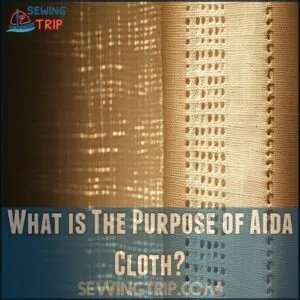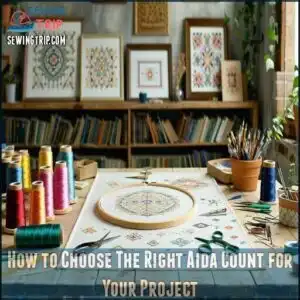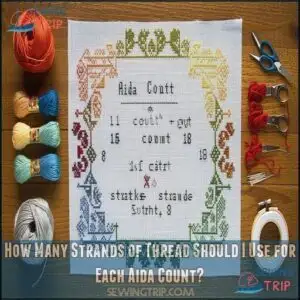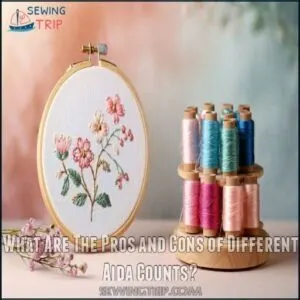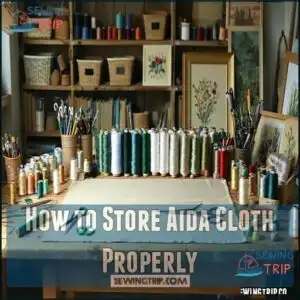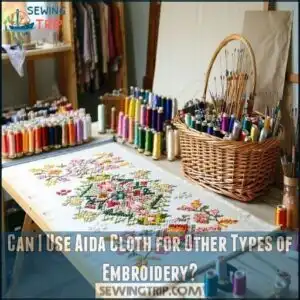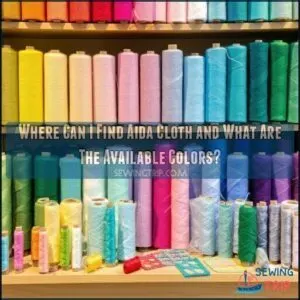This site is supported by our readers. We may earn a commission, at no cost to you, if you purchase through links.
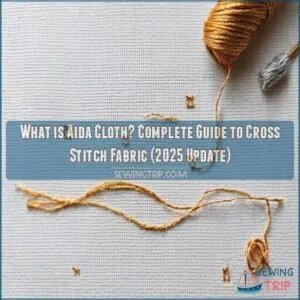
Its open, even weave creates perfectly spaced holes, so your stitches stay neat and aligned. You’ll find it in different “counts,” like 11, 14, 16, and 18, which just means how many squares fit in an inch—lower counts have bigger holes.
It’s usually made of cotton and comes in lots of colors, making it versatile for projects. Aida cloth simplifies stitching and adds a polished look to your designs.
Curious about choosing the right count or thread? Stick around for practical tips!
Table Of Contents
- Key Takeaways
- What is Aida Cloth?
- What is The Purpose of Aida Cloth?
- What Are The Different Sizes or Counts of Aida Cloth?
- How to Choose The Right Aida Count for Your Project
- How Many Strands of Thread Should I Use for Each Aida Count?
- What Are The Pros and Cons of Different Aida Counts?
- How Much Aida Cloth Will I Need for My Project?
- How to Store Aida Cloth Properly
- Can I Use Aida Cloth for Other Types of Embroidery?
- Where Can I Find Aida Cloth and What Are The Available Colors?
- Frequently Asked Questions (FAQs)
- Conclusion
Key Takeaways
- Aida cloth’s evenly spaced holes and grid-like structure make it beginner-friendly and perfect for cross-stitch projects.
- The fabric comes in various counts, like 11, 14, 16, and 18, which determine the size of stitches and project detail.
- It’s usually made of 100% cotton, offering a stiff texture that helps with tension and eliminates the need for hoops.
- Choosing the right count depends on your experience, project size, and desired level of detail.
What is Aida Cloth?
Aida cloth is the backbone of cross stitch projects, created by Zweigart & Sawitzki in the 1890s.
Aida cloth, crafted in the1890s, remains the ultimate beginner-friendly foundation for stunning cross stitch designs.
This special evenweave fabric features an open weave design with evenly spaced holes forming a perfect grid structure – like graph paper you can stitch on.
When you look closely at Aida, you’ll notice those distinctive squares create a roadmap for your needle, making it incredibly beginner-friendly.
The fabric comes in various fabric counts (squares per inch), with each count offering different levels of detail for your counted cross stitch projects.
Most crafters recognize Aida’s stiff texture and raised center threads that help your stitches pop beautifully.
While sometimes called Java Canvas, it’s primarily known simply as Aida.
What makes this cross stitch fabric special is its purpose-built design – unlike general embroidery fabrics, Aida’s consistent grid was created specifically to make counting stitches effortless and enjoyable.
Aida’s design is key to its popularity, making it a favorite among crafters for its ability to provide a perfect grid structure, and its evenly spaced holes are a testament to its beginner-friendly nature.
What is The Purpose of Aida Cloth?
Now that we’re familiar with Aida cloth, let’s explore why it’s the backbone of cross stitch projects everywhere.
The magic of Aida cloth lies in its perfectly spaced holes that create a built-in grid for your needle.
Aida cloth’s magic is its perfectly spaced holes, creating a natural grid that makes cross-stitching effortless and enjoyable.
This fabric serves four primary purposes:
- Makes counting stitches intuitive for beginners
- Maintains even tension across your entire project
- Provides natural stiffness that often eliminates the need for hoops
- Creates uniform X-shaped stitches that look professional
Unlike evenweave alternatives, Aida’s structure guides your needle exactly where it needs to go, making counted thread work accessible to stitchers of all levels, and it is known for its perfectly spaced holes and natural stiffness.
What Are The Different Sizes or Counts of Aida Cloth?
Once you understand the purpose of Aida cloth, it’s time to explore its different sizes or "counts."
The count number simply tells you how many squares fit into one inch of fabric.
Here’s what you need to know:
You’ll find 14 count Aida most commonly in craft stores – it’s like the "medium" t-shirt of crossstitch fabrics.
The higher the count, the smaller your finished piece will be for the same pattern.
Fabric thickness generally decreases as count increases, while stitch density appears tighter on higher counts.
Choosing the right fabric count options is essential for achieving the desired look and feel of your cross-stitch project.
How to Choose The Right Aida Count for Your Project
Picking the right Aida count can make or break your cross-stitch project, so you’ll want to take into account your experience level, project size, and how detailed you want your finished piece to look.
You’ll find that beginners often start with 14-count Aida (offering a good balance of ease and detail), while more experienced stitchers might prefer 18-count for those intricate designs that really show off your skills.
Consider Project Size
Before diving into your cross stitch journey, project size is essential for fabric count selection.
Your design’s dimensions directly impact Aida fabric needs:
- Large patterns work best on 11-14 count Aida for manageable project handling
- Detailed designs need 16-18 count for capturing intricate elements
- Wall-sized creations require 11 count to maintain reasonable stitch density
Always add 3-4 inches of border space for framing and handling. Understanding Aida cloth counts is essential for selecting the right fabric.
This understanding will help in making informed decisions about your cross stitch journey and ensure that you choose the appropriate Aida fabric for your project.
Choose Based on Experience
Your stitching experience plays a huge role in fabric selection. Beginners should start with 11-14 count Aida cloth – these larger squares make thread counting easier and forgive small mistakes.
As your skill level improves, try 16 count for more detailed work. Advanced stitchers often prefer 18-22 count for intricate projects with fine details.
Remember, there’s no rush to move up in difficulty – mastering basics on lower-count Aida builds confidence for tackling more complex patterns later.
When selecting the right Aida cloth, consider the Aida cloth quality to guarantee the best results for your project, focusing on Aida cloth and ensuring the best results.
Factor in Visual Preference
Visual preference might be your most important factor when selecting Aida fabric count.
- Lower counts (11-14) create bold, chunky stitches visible from across the room
- Higher counts (18-22) deliver delicate, painting-like details for intricate designs
- Medium counts (16) offer a sweet spot between visibility and refinement
- Darker Aida cloth makes thread colors pop dramatically
- White or cream fabric creates a classic, traditional cross stitch appearance
Consider how thread thickness affects stitch density on different counts – thicker threads on higher-count fabric create texturally interesting, raised designs. Understanding Aida fabric counts is essential for achieving the desired visual effect in your cross-stitch project.
How Many Strands of Thread Should I Use for Each Aida Count?
For perfect cross stitch projects, matching your thread strands to your Aida count is essential. Your strand choice directly affects stitch appearance and fabric coverage.
- For 14-count Aida (the most common), use two strands for balanced coverage and easy stitching
- For 18-count or higher Aida, try one strand for cleaner, more defined stitches
- For 11-count Aida, three strands provide better coverage for those larger holes
Remember, standard embroidery thread comes with six strands you can separate. Too many strands create bulky stitches; too few leave fabric peeking through. To achieve superior results, consider thread count guidelines when selecting your strands. This will help you make an informed decision for your cross stitch projects and ensure the best possible outcome with the right thread strands.
What Are The Pros and Cons of Different Aida Counts?
Choosing the right Aida fabric count can feel like picking the perfect puzzle piece—it’s all about fit. Each Aida count impacts your project’s stitch density, detail level, and ease of use.
Here’s a quick Aida Count Comparison to help you decide:
Aida Count Pros Cons
11-count
14-count
16-count
18-count
22-count
Lower counts like 11-count Aida fabric are beginner-friendly with visible holes but require more thread. Meanwhile, higher counts, such as a 22-count Aida cloth, offer breathtaking detail for advanced cross stitch or embroidery.
Consider your experience, project size, and your patience level before making your fabric selection!
How Much Aida Cloth Will I Need for My Project?
Getting the right amount of cross stitch fabric starts with project sizing. Measure your pattern’s stitch count, then factor in fabric measurement margins.
- Add 2–3 inches per side for basic framing.
- Leave 4–6 inches for large wall art.
- Use 3 inches minimum for hoop projects.
Your Aida cloth count matters too! A 14-count fabric uses more space than an 18-count.
Keep stitch density and your yarn requirements in mind. Always buy extra fabric—it’s like packing snacks: better to have it and not need it!
How to Store Aida Cloth Properly
Storing Aida cloth right keeps your cross stitch fabric in great shape!
Skip folding—rolling works better for fabric storage as it avoids creases. Use airtight containers or resealable bags to shield against dust and moisture. Add silica gel packets for moisture control and label everything with fabric count and size for easy access.
- Store Aida cloth rolls horizontally in cool, dark places.
- Layer acid-free tissue paper between rolls for fray prevention.
- Prevent wrinkles with low-heat ironing if needed.
- Protect edges with hemming or fray-stop.
Can I Use Aida Cloth for Other Types of Embroidery?
Although Aida cloth is designed for cross stitch, it works for other embroidery techniques too.
Its grid-like structure is perfect for counted thread fabric projects such as blackwork embroidery or samplers, where precise placement is key.
You can also use it for basic stitches, like running stitch and backstitch, thanks to its evenly spaced holes.
However, Aida cloth has stitch limitations.
Its large, visible holes can make it tricky for decorative stitches or surface embroidery techniques that need more flexibility or finer detail.
For those, consider fabric alternatives like evenweave or linen, which allow freer stitch placement and smoother finishes.
If you’re new to needlework fabric, Aida cloth remains a friendly choice.
It’s forgiving, easy to handle, and great for experimenting.
Just know its limits and select the right fabric for your project’s embroidery techniques.
Where Can I Find Aida Cloth and What Are The Available Colors?
When it’s time to pick up Aida cloth for your cross-stitch projects, you’ve got plenty of options.
Local craft shops like Joann, Michaels, and Hobby Lobby usually carry a reliable selection of Aida fabric sizes and colors. You’ll find basics like white, cream, and black on their shelves, which are perfect if you’re just starting.
For a wider variety, hop online. Retailers such as 123Stitch, Everything Cross Stitch, and Zweigart’s official store stock an incredible range of cross-stitch fabric, including unique Aida fabric colors like pastels, bold jewel tones, and even hand-dyed variations.
Online marketplaces are great for digging up hard-to-find Aida cloth sizes or special finishes. Not sure where to begin? Try a 14-count white Aida cloth. It’s beginner-friendly, easy to work with, and widely available in both craft shops and online retailers.
You’ll be stitching in no time! To prevent fraying, consider using edge finishing techniques to protect your project.
Frequently Asked Questions (FAQs)
What Are Some Tips for Stitching on Higher Count Aida Cloth?
Choose a finer needle, like size 26 or 28, and use good lighting or a magnifier.
Stitch with one thread for cleaner details.
Take breaks often to avoid eye strain—it’s tricky but rewarding!
Is Aida Cloth the Best Choice for Beginners?
Think of Aida cloth as training wheels for cross-stitch.
Its grid-like structure makes counting easy, helping beginners avoid mistakes.
With 14-count being a favorite, it’s beginner-friendly, versatile, and ideal for mastering the basics.
How Do I Determine the Size of Aida Cloth I Need for My Project?
Measure your design’s stitch count, add extra inches for framing (about 2-3 inches per side), and divide by your Aida cloth’s count.
For example, 100 stitches on 14-count Aida equals approximately 7 inches.
Where Can I Find Aida Cloth and What Are the Different Colors Available?
You can find Aida cloth at craft stores, online retailers, or specialty needlework shops.
It comes in many colors like white, cream, navy, and even pastels, perfect for matching your cross-stitch project’s design.
What can I use instead of Aida cloth?
If Aida cloth feels too mainstream, try evenweave or linen.
Both have finer grids, perfect for detailed stitching.
For free-form embroidery, plain cotton works too.
Just prep the edges so they don’t fray.
How do you pronounce Aida cloth?
You say “Eye-EE-duh” when pronouncing Aida cloth.
It’s like saying “idea” but with an extra “uh” in the middle.
The name comes from an Italian opera, so it’s got flair!
What is the difference between 14 count and 18 count Aida cloth?
Think of 14-count Aida like training wheels—it’s beginner-friendly, with bigger squares for easier stitching.
On the other hand, 18-count offers finer, smaller squares, ideal for detailed designs but requiring more precision.
What is Aida cloth made of?
It’s made from 100% cotton, giving it a soft yet firm feel that’s great for cross-stitching.
The evenly spaced holes create a grid-like pattern, making it easier to keep your stitches neat and tidy, which is a key aspect of cross-stitching.
What are some tips for stitching on higher count Aida cloth?
Using 18-count or higher creates intricate designs with tiny squares (22 per inch!).
Use sharper needles, great lighting, and one thread strand.
Take breaks to relax your eyes, and secure fabric edges to prevent fraying, this is a complete concept to follow for best results.
Is Aida cloth the best choice for beginners?
Yes, Aida cloth is great for beginners.
Its grid-like holes make stitching easier, guiding each cross neatly.
Start with 11- or 14-count for larger spaces and less eye strain—ideal for learning the basics.
Conclusion
So, now you know what aida cloth is and why it’s the go-to fabric for cross-stitch projects.
Its neat weave and different counts let you tackle everything from beginner designs to detailed masterpieces.
Picking the right count depends on your project’s size, your experience, and what look you’re after.
Keep it stored flat and clean, and you’ll always have it ready, whether you’re stitching flowers or quotes, aida cloth makes your designs pop every time.
- https://en.wikipedia.org/wiki/Aida_cloth
- https://thecraftymummy.com/2017/08/which-count-aida-cloth-should-i-use-for-my-cross-stitch/
- https://www.dmc.com/US/en/products/aida-embroidery-fabric
- http://www.lostincrossstitch.com/aida-fabric-cross-stitch/
- https://www.catkinandlillie.com/post/fabric-for-cross-stitch-aida-evenweave-and-linen

